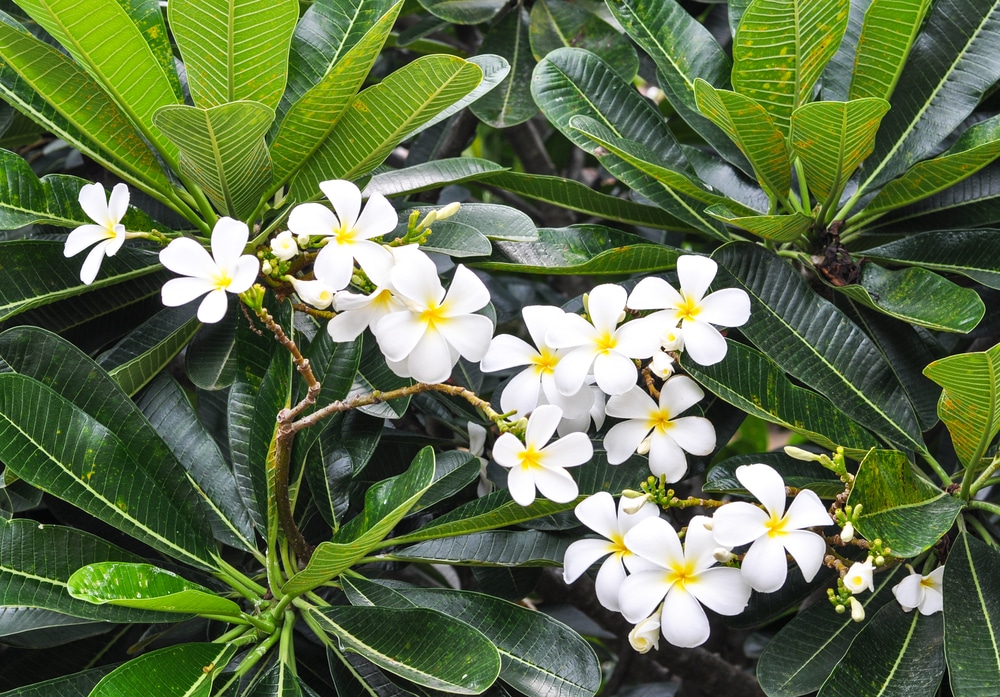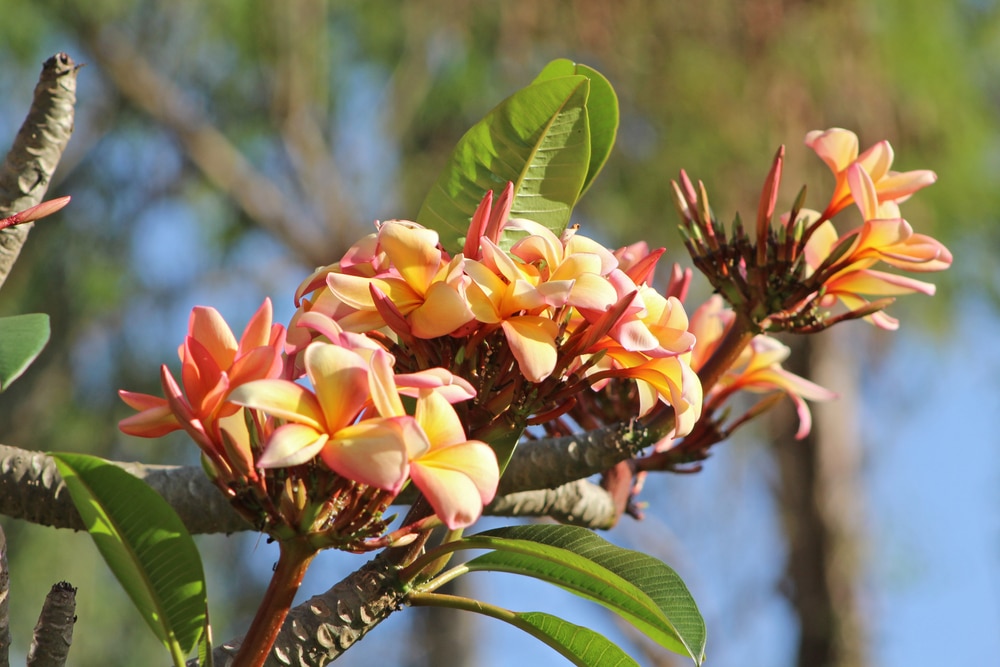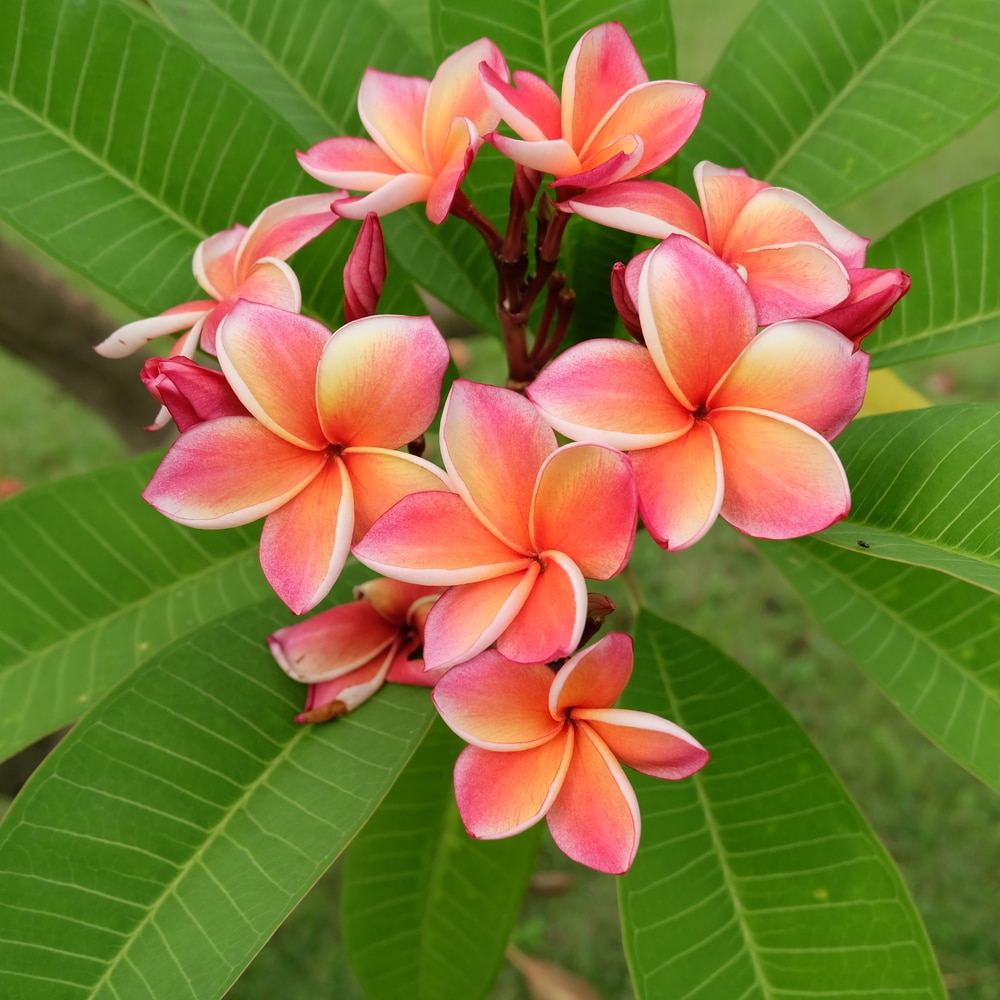Trying to get your plumeria to bloom? Then you’ll want to read our entire article.
Although their sausage-like branches give plumerias a distinctive look, it’s really all about their colorful and fragrant pinwheel-shaped blooms. Just one look and sniff and it’s easy to see why the blossoms add an eye-catching tropical appeal to gardens. Plumeria are hardy plants and best of all, you don’t have to be a horticultural specialist to have them burst into bloom.
Make sure to also check out our many articles on raising vegetables and herbs. For instance, you may be interested in learning how to raise Basil indoor year round, regardless of the weather outside.

Common Varieties
A genus that contains 11 species of shrubs and small trees, Plumeria is native to tropical regions of the Americas, as well as the Caribbean. Of the 11 species, only a few are commonly found and grown in gardens. However, of the common varieties, there are hundreds of cultivars and hybrids that basically differ in plant size and flower color.
Three of the most common are Plumeria rubra, alba, and obtusa. All three have the same requirements when it comes to soil, sun, water, and winter care.
Rubra
Plumeria rubra develops into a small deciduous tree growing 15 to 25 feet tall with a similar width. It develops a vase-shape at maturity with dark green elliptic leaves growing up to 12 inches long and forming at the end of branches. The showy and very fragrant 5-petaled flowers are red to pink, although there are numerous cultivars with a vast selection of differing bloom colors.

Alba
Plumeria alba forms into a vase-like, deciduous small tree growing 20 to 25 feet tall and wide. The dark green elliptic leaves form at the end of the branches and grow over 12 inches long. The plant produces fragrant and showy white blossoms with a small yellow center.

Obtusa
Plumeria obtusa forms into a small tree averaging around 10 to 15 feet tall and wide. In warmer climates it can be semi-evergreen, and in cooler climates it is deciduous.
The narrow, glossy dark green leaves are long and oval with blunt ends and grow around 8 inches long. Fragrant and showy flowers are white with a yellow center, although there are various cultivars sporting different colored blooms.

Common Cultivars
There are numerous cultivars sporting a variety of different colored blooms. Colors include yellow, gold, pinks, reds, orange, and white and many bicolor mixes. Some of the more common cultivars are listed below.
‘Candy Stripe’
The showy and fragrant blooms are striped in the colors of white, pink, and gold.
‘Intense Rainbow’
Flower blooms are quite showy, blooming in mixed shades of dark reddish-pink and golden-yellow.
‘Dwarf Pink Singapore’
A dwarf variety that blooms with white flowers with longer petals and pink flower stems. In warmer locales, it continues blooming even in winter.
‘Aztec Gold’
This plumeria plant produces sunny yellow blooms with tinges of white on the end portion of the petals.
‘Thailand Red’
Forms into a compact plant blooming with quite showy and fragrant dark pinkish-red blooms.

When Do Plumerias Bloom
Compared to many types of deciduous plants, plumeria can take a bit longer to start developing foliage on the sausage-like branches in spring. It’s not unusual for the plant to wait until late spring until it starts leafing out and the blooming occurs.
In fact, in cooler locations within its range, the plant can remain leafless and flowerless for up to six months. However, and even though leafless for almost half the year, the thick and blunt greyish-green branches make an unusual and unique addition to tropical landscapes.
The vast majority of Frangipani flowers won’t start developing blooms until early summer, forming clusters at the end of branches. Once the blooming begins, it continues through early fall. However, some cultivars of Plumeria obtusa continue flowering through winter in locations that remain consistently warm.
Once the plant starts blooming, it makes a showy and eye-catching specimen in the landscape or dressing up a hardscape area. The branch tips filled with the fragrant and colorful flower clusters are sure to brighten up the garden for at least half the year.

How to Encourage Blooms
The best way to ensure beautiful blooms is by providing proper care and ideal growing conditions. A healthy plumeria plant produces robust growth and a wealth of colorful blooms almost through fall. Depending on the variety, some Frangipani produce 200 blooms or more per season, while others might only produce around 50.
Also, a plumeria that is densely packed with branches produces more blooms than those that are leggy. Trimming back long branches promotes the plumeria to grow an additional two or three where the branch was cut.
Ideal Growing Conditions
Amount of Light
These tropical plants thrive in full sun all day without skipping a beat. The sunnier the location, the more your plumeria will flourish, producing the best growth.
That being said, they can also can survive with less sun. For optimal growth, it should receive at least 6 hours of full sun daily and partial sun for the remainder of the day. Too much shade will slow the growth, lead to thin and leggy branches, and a reduce blooms.
If you are growing in a pot, you have the advantage of placing it in the optimal position for adequate light. If you will be growing it outdoors, then situate it where it will receive the most sunlight, preferably 6 hours. If you are raising it indoors, the place it in a sunroom or near a south-facing window.

Preferred Soil Conditions
Plumeria isn’t too particular about its soil as long as that soil drains well. Therefore, you shouldn’t plant in an area prone to flooding or where the soil remains soggy for long periods. If left in soggy soils for prolonged periods of time, it will eventually lead to root rot. Root rot will lead to poor growth and flower productions and eventually will lead to plant death.
They also prefer soil that is slightly acidic. Planting in soil with a pH of 6.4 to 6.8 is sufficient.
In the landscape, sandy or loamy soil works well and for containers, use a potting mix or cactus blend that drains well. Some straight potting soils, not potting mixes, are too heavy and don’t drain properly. However, you can lighten the mix by adding amendments like sterile sand or perlite. Some potting mixes even contain a slow-release fertilizer that feeds the plumeria for up to three months.
Watering Requirements
While the plumeria is producing active growth (particularly in the summer), make sure to provide enough water. Although relatively drought-tolerant once established, inadequate watering can cause the plumeria to suspend additional growth and go into a dormant state. If it does not receive enough water, it can reduce its water loss by aborting developing flower stalks, resulting in a possible season of lost blooms.
While you don’t want the plumeria to have wet feet from residing in standing water, you also don’t want to allow the soil to remain completely dry for months on end.
If the plumeria is planted in the landscape and you haven’t watered in a while or it hasn’t rained, give it a deep drink of water, especially if outdoor conditions are hot. Watering every week saturating the roots should be sufficient. You can help the soil retain moisture by applying several inches of mulch around the base of your plant. During winter, when the plumeria goes through dormancy, you can cut back watering to half.

If you are growing in a pot, you can easily check soil moisture by sticking your finger into the potting mix. When the top several inches feel dry to the touch, apply water until it runs from the bottom drain holes. During summer, you may have to water every other day. Additionally, make sure that the containers you are using always have a drain hole at the bottom to prevent problems with rot and too soggy soil.
When the plumeria is dormant in winter, you can cut back apply water to every week or two. Don’t forget to bring the container into a warm, protected location if your winter weather is prone to frosts and freezes. Grow it in an indoor location with bright light.
Fertilization
After planting the plumeria in a warm site receiving at least 6 hours of full sun, with well-drained soil and irrigating properly, the next important step is applying fertilizer. Just like people, plumeria requires adequate nutrients for bloom production and healthy growth.
When using fertilizer for the productions of blooms, make sure to use a product that contains a high amount of phosphorus. When looking at a fertilizer package and you see the three main numbers (NPK).
Nitrogen
The first number on the fertilizer package (N) represents the amount of nitrogen found in the product. Nitrogen helps in producing good green growth. However, you don’t want to use a fertilizer that is too high in nitrogen or you will have robust growth at the expense of flower production. Select a fertilizer blend that has a lower nitrogen content.
Phosphorus
Phosphorus (P) is the middle number and is what’s needed for plumeria blooms. Phosphorus assists in making the blooms more abundant and larger. Select a fertilizer product with a higher middle number.
Potassium
The last number is potassium (K), and it is needed for healthy overall growth and root development. When selecting a fertilizer, the potassium content doesn’t have to be as much as the fertilizer’s phosphorus content. Using a fertilizer blend with an NPK ratio like a 10-15-10 works well.
Fertilization for Plants in Containers
Plumerias grown in containers are more dependent on feeding applications than those grown in landscape. Those grown directly in the garden’s soil can gain some nutrients from the soil they are growing in, whereas potted plumerias depends on the potting mix.
We recommend using a water-soluble blend that can be applied to your potted plant at your regular scheduled watering time. Using a fertilizer with higher phosphorus content will help increase the chance of big blooms.

Fertilization Frequency
When applying a granular fertilizer to plants grown in the landscape, use the amount suggested on the label and spread evenly over the growing site. Be sure not to allow the product to butt against the trunk or it can suffer burning. Once applied, be sure to thoroughly water into the planting site.
If you have a layer of mulch covering the planting site, you’ll need to rake it so the fertilizer makes better contact with the soil. Rake the mulch towards the plumeria’s drip line and spread the fertilizer. Spread the mulch back over the site and water the soil.
When it comes to the frequency of use, apply a fertilizer every four to six weeks. Don’t apply too much or it will result in burned foliage. During winter and while the plumeria is dormant, cease all fertilizer applications and restart again in spring.
For plumeria grown in containers, feed monthly. Mix a water-soluble blend into a watering can and apply it when you normally water, allowing it to saturate the root system. Since the salts in fertilizer can eventually build up in the potting mix and cause burning, flush the soil every six months or so. Allow water to gently run through the container’s soil for about five minutes to remove any salt buildup. Additionally, cease fertilizing in winter while the plumeria is dormant.

How Long Do Blooms Last
A healthy and productive plumeria usually starts blooming in early summer, which generally continues into early fall. However, some varieties grown in consistently warm climates can bloom almost year-round.
When it comes to flowers lasting once they bloom, flower clusters typically last for almost a week. Once they are spent, the flowers drop naturally from the tree. If the flowers are pollinated by moths, butterflies or other beneficial pollinators, a long seed pod is produced where the flower once was. Once the seed pod becomes brown and starts to split open, the seeds are ripe and can be planted to produce additional plumeria plants.
You can also enjoy the attractive blooms indoors. Gently pick the plumeria blooms from the flower cluster and bring indoors. Fill a bowl with room temperature tap water and allow the blooms to float on top. The blooms should last several days in cool indoor temperatures.


Very informative and helpful…thank you!!
My plumeria has buds on it so I’m grateful for the information on how long they may last. Thank you.
I live in Pennsylvania. My plumeria started to bud towards the fall. I didn’t want to lose the buds and flowers so I placed a plant light to shine on them over the winter. A few flowers bloomed. Will they continue to bloom now that I put it back outside this spring?
My plumerias are very healthy with dark green leaves. It’s August and I have 12 potted plants and yet to bloom. We’ve add led NKP
love this article,live in st.louis but am tying to start a plant,having problems getting it to flower,thanks for the article